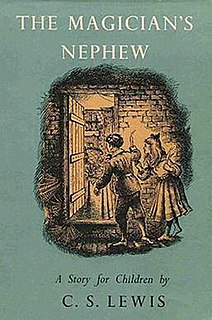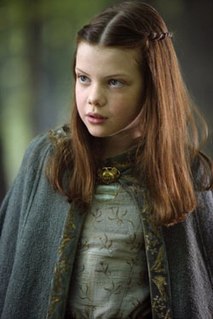
The Chronicles of Narnia is a series of seven fantasy novels by C. S. Lewis. It is considered a classic of children's literature and is the author's best-known work, having sold over 100 million copies in 47 languages. Written by Lewis, illustrated by Pauline Baynes, and originally published in London between 1950 and 1956, The Chronicles of Narnia has been adapted several times, complete or in part, for radio, television, the stage, and film.

The Magician's Nephew is a high fantasy novel for children by C. S. Lewis, published by Bodley Head in 1955. It is the sixth published of seven novels in The Chronicles of Narnia (1950–1956); it is volume one of the series in recent editions, which sequence the books according to Narnia history. Like the others, it was illustrated by Pauline Baynes whose work has been retained in many later editions. The Bodley Head was a new publisher for The Chronicles, a change from Geoffrey Bles.

The Lion, the Witch and the Wardrobe is a fantasy novel for children by C. S. Lewis, published by Geoffrey Bles in 1950. It is the first published and best known of seven novels in The Chronicles of Narnia (1950–1956). Among all the author's books, it is also the most widely held in libraries. Although it was originally the first of The Chronicles of Narnia, it is volume two in recent editions that are sequenced by the stories' chronology. Like the other Chronicles, it was illustrated by Pauline Baynes, and her work has been retained in many later editions.

Narnia is a fantasy world created by C. S. Lewis as the primary location for his series of seven fantasy novels for children, The Chronicles of Narnia. The world is so called after the country of Narnia, in which much of the action of the Chronicles takes place.

Tumnus is a fictional character in the Narnia books, written by C.S. Lewis. He is featured prominently in The Lion, the Witch and the Wardrobe and also appears, with a lesser role, in The Horse and His Boy and The Last Battle. He is close friends with Lucy Pevensie and is the first creature she meets in Narnia, as well as the first Narnian to be introduced in the series. Lewis said that the first Narnia story, The Lion, the Witch and the Wardrobe, all came to him from a single picture he had in his head of a faun carrying an umbrella and parcels through a snowy wood. In that way, Tumnus was the initial inspiration for the entire Narnia series.

Charn is a fictional city appearing in the 1955 book The Magician's Nephew, the sixth book published in C. S. Lewis's Chronicles of Narnia, written as a prequel to The Lion, the Witch, and the Wardrobe. Charn, and the world of which it is the capital city, are the birthplace of Jadis, the evil White Witch who later takes over Narnia. When visited briefly by Digory and Polly, the protagonists of the novel, the city is totally deserted, lifeless and crumbling, under a dying sun. Rivers have dried up, and neither weeds nor insects live. All life on the world of Charn had been destroyed by Jadis through an evil magic spell. In the novel, the city stands as an example of the dead end that can result if a civilization succumbs to evil.

Lucy Pevensie is a fictional character in C. S. Lewis's The Chronicles of Narnia series. She is the youngest of the four Pevensie children, and the first to find the Wardrobe entrance to Narnia in The Lion, the Witch and the Wardrobe. Of all the Pevensie children, Lucy is the closest to Aslan. Also, of all the humans who have visited Narnia, Lucy is perhaps the one that believes in Narnia the most. She is ultimately crowned Queen Lucy the Valiant, co-ruler of Narnia along with her two brothers and her sister. Lucy is the central character of the four siblings in the novels. Lucy is a principal character in three of the seven books, and a minor character in two others.

Peter Pevensie is a fictional character in C. S. Lewis's The Chronicles of Narnia book series. Peter appears in three of the seven books; as a child and a principal character in The Lion, the Witch and the Wardrobe and Prince Caspian, and as an adult in The Last Battle. He is only mentioned in The Horse and His Boy in which he is away on the northern frontier fighting giants and in The Voyage of the Dawn Treader in which he is studying under the tutelage of Professor Kirke.

Professor Digory Kirke (1888-1949) is a fictional character from C. S. Lewis' fantasy series The Chronicles of Narnia. He appears in three of the seven books: The Lion, the Witch and the Wardrobe, The Magician's Nephew, and The Last Battle.
Mr. and Mrs. Beaver are fictional characters in C. S. Lewis's The Chronicles of Narnia. In The Lion, the Witch and the Wardrobe they are instrumental in conveying the Pevensie children to Aslan, and they appear briefly in the final novel The Last Battle.

The Chronicles of Narnia: The Lion, the Witch and the Wardrobe is a 2005 British-American high fantasy film directed by Andrew Adamson and based on The Lion, the Witch and the Wardrobe, the first published and second chronological novel in C. S. Lewis's children's epic fantasy series, The Chronicles of Narnia. It was co-produced by Walden Media and Walt Disney Pictures and distributed by Buena Vista Pictures. William Moseley, Anna Popplewell, Skandar Keynes and Georgie Henley play Peter, Susan, Edmund, and Lucy, four British children evacuated during the Blitz to the countryside, who find a wardrobe that leads to the fantasy world of Narnia. There they ally with the Lion Aslan against the forces of Jadis, the White Witch.
Lantern Waste is a fictional place in The Chronicles of Narnia series by C. S. Lewis. It is a wood and is notable as the place where Lucy Pevensie and Mr. Tumnus meet, which is the first scene of Narnia described in the books. The lamppost in the wood is an iconic image of Narnia, and the question of its origin is what convinced Lewis to write more than one book on Narnia. One of King Edmund's titles is Duke of Lantern Waste.[PC]
In C. S. Lewis's fantasy novel series the Chronicles of Narnia, the hill of the Stone Table, or Aslan's How, is a high mound or cairn south of the Great River in Narnia next to the Great Woods. The How was built over the hill of the Stone Table. The word how derives from the Old Norse haugr, meaning hill or mound. In parts of England, it is a synonym for barrow.
The Chronicles of Narnia is a series of films based on The Chronicles of Narnia, a series of novels by C. S. Lewis. From the seven books, there have been three film adaptations so far—The Lion, the Witch and the Wardrobe (2005), Prince Caspian (2008) and The Voyage of the Dawn Treader (2010)—which have grossed over $1.5 billion worldwide among them.

Aslan is a major character in C. S. Lewis's The Chronicles of Narnia series. He is the only character to appear in all seven books of the series. C.S. Lewis often capitalises the word lion in reference to Aslan since he parallels Jesus Christ.
The Lion, the Witch and the Wardrobe is a British children's television drama first broadcast by the BBC in 1988. It was the first series of The Chronicles of Narnia that ran from 1988 to 1990.

The Lion, the Witch and the Wardrobe is an animated television film that was broadcast on CBS in 1979, based on the novel of the same name by C. S. Lewis.

Maugrim is a fictional character in the novel The Lion, the Witch and the Wardrobe by C. S. Lewis. A Narnian wolf, he is the Captain of the White Witch's Secret Police. In early American editions of the book, Lewis changed the name to Fenris Ulf, but when HarperCollins took over the books they took out Lewis' revisions, and the name Maugrim has been used in all editions since 1994.
The following outline is provided as an overview of and topical guide to Narnia:














